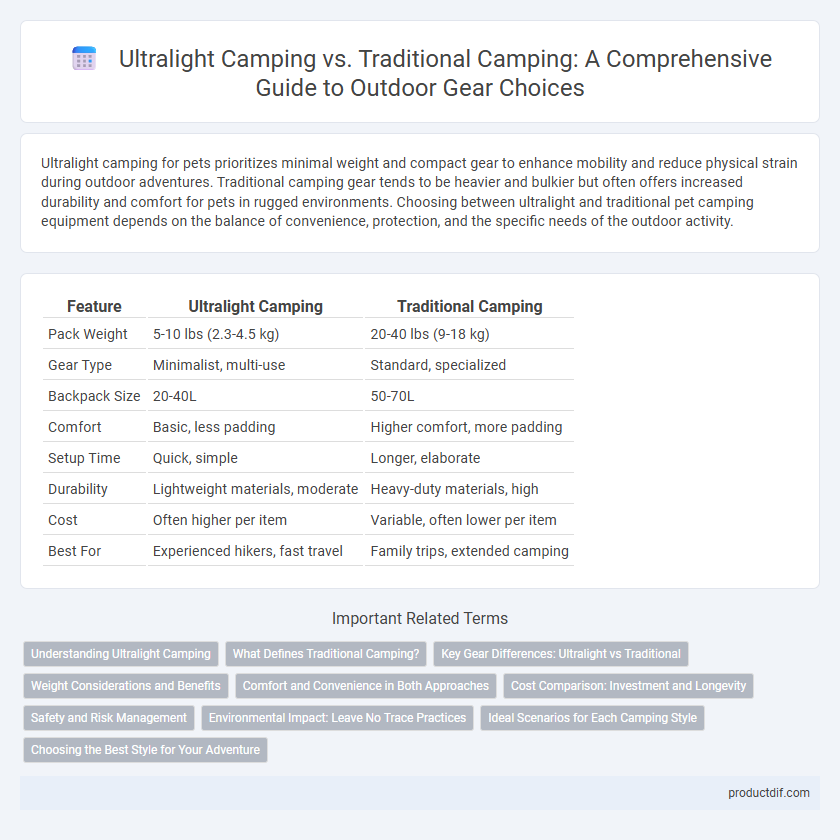Ultralight camping for pets prioritizes minimal weight and compact gear to enhance mobility and reduce physical strain during outdoor adventures. Traditional camping gear tends to be heavier and bulkier but often offers increased durability and comfort for pets in rugged environments. Choosing between ultralight and traditional pet camping equipment depends on the balance of convenience, protection, and the specific needs of the outdoor activity.
Table of Comparison
| Feature | Ultralight Camping | Traditional Camping |
|---|---|---|
| Pack Weight | 5-10 lbs (2.3-4.5 kg) | 20-40 lbs (9-18 kg) |
| Gear Type | Minimalist, multi-use | Standard, specialized |
| Backpack Size | 20-40L | 50-70L |
| Comfort | Basic, less padding | Higher comfort, more padding |
| Setup Time | Quick, simple | Longer, elaborate |
| Durability | Lightweight materials, moderate | Heavy-duty materials, high |
| Cost | Often higher per item | Variable, often lower per item |
| Best For | Experienced hikers, fast travel | Family trips, extended camping |
Understanding Ultralight Camping
Ultralight camping emphasizes minimalism by reducing the weight of gear to enhance mobility and comfort on long hikes, often using specialized materials like titanium and Dyneema. Key equipment includes lightweight tents, compact sleeping bags, and multipurpose tools designed to balance durability and weight savings. This approach improves efficiency and reduces fatigue compared to traditional camping, which typically involves heavier and bulkier gear.
What Defines Traditional Camping?
Traditional camping is defined by carrying heavier, bulkier gear including large tents, thick sleeping bags, and extensive cooking equipment designed for comfort and durability. It emphasizes comprehensive preparation with multiple accessories to ensure a more home-like experience in the outdoors. This approach prioritizes comfort and convenience over minimal weight, contrasting sharply with ultralight camping's focus on reducing pack weight to enhance mobility.
Key Gear Differences: Ultralight vs Traditional
Ultralight camping gear prioritizes minimal weight, using advanced materials like titanium stoves, carbon fiber trekking poles, and cuben fiber tents, making backpacks under 10 pounds feasible. Traditional camping equipment often includes heavier items such as steel cookware, bulky sleeping bags, and large tents designed for comfort rather than weight savings. These key gear differences directly impact mobility, endurance, and overall trip duration, with ultralight setups favoring fast, long-distance hiking and traditional gear suited for car camping or multi-day excursions with ample comforts.
Weight Considerations and Benefits
Ultralight camping prioritizes minimal weight, often keeping pack loads under 10 pounds, which enhances mobility and reduces fatigue on trails. Traditional camping typically involves bulkier gear exceeding 30 pounds, offering more comfort and versatility at the cost of increased physical strain. Choosing ultralight gear maximizes efficiency and speed, while traditional setups provide greater protection and amenities for extended or stationary trips.
Comfort and Convenience in Both Approaches
Ultralight camping prioritizes minimal weight, enhancing mobility but often compromises on comfort by using compact, minimalist gear such as lightweight sleeping pads and smaller tents. Traditional camping emphasizes comfort and convenience with bulkier equipment, like thicker sleeping mats and larger tents, providing more insulation and space for a restful experience. Choosing between ultralight and traditional camping depends on whether ease of transport or enhanced comfort during overnight stays is the primary goal.
Cost Comparison: Investment and Longevity
Ultralight camping gear requires a higher initial investment due to advanced materials like titanium and Dyneema, but it offers superior durability and weight savings that reduce long-term replacement costs. Traditional camping equipment is generally more affordable upfront but may wear out faster, leading to more frequent purchases and higher cumulative expenses. Evaluating the cost-effectiveness of each approach depends on usage frequency, with ultralight gear favored by serious backpackers seeking long-term efficiency.
Safety and Risk Management
Ultralight camping emphasizes minimizing weight, which can limit the amount and type of safety equipment carried, increasing risk exposure in harsh weather or emergencies. Traditional camping allows for more comprehensive gear, including robust shelter and extra supplies, enhancing risk management and preparedness for unpredictable conditions. Prioritizing safety requires balancing ultralight efficiency with essential protective items to mitigate potential hazards effectively.
Environmental Impact: Leave No Trace Practices
Ultralight camping significantly reduces environmental impact by minimizing gear weight and volume, which leads to less disturbance of natural areas and fewer resources used in manufacturing. Traditional camping often involves heavier equipment that can compact soil and damage vegetation, increasing the risk of environmental degradation. Both styles benefit from strict adherence to Leave No Trace principles, emphasizing waste management, respecting wildlife, and minimizing campsite impact to preserve ecosystems.
Ideal Scenarios for Each Camping Style
Ultralight camping excels in scenarios requiring long-distance hiking, fast travel, and minimal physical strain, where every ounce counts for efficiency and speed. Traditional camping suits extended stays, family trips, or situations where comfort, gear variety, and durability are prioritized over pack weight. Selecting the ideal camping style depends on the trip duration, terrain difficulty, and personal preferences for convenience versus mobility.
Choosing the Best Style for Your Adventure
Ultralight camping emphasizes minimal gear weight, maximizing mobility and reducing physical strain, ideal for long-distance trekking and fast-paced adventures. Traditional camping offers robust equipment and comfort, suited for casual trips or group settings where durability and ample supplies are prioritized. Selecting the best style depends on trip duration, terrain difficulty, and personal preferences for balance between convenience and preparedness.
Ultralight camping vs Traditional camping Infographic

 productdif.com
productdif.com